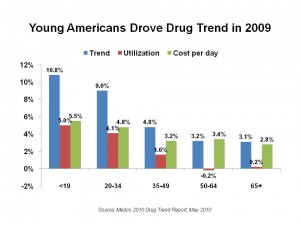 The growth in kids’ use of prescription drugs was 4 times greater than that for the overall U.S. population in 2009. 1 in 4 insured kids and 30% of insured people age 10-19 took a drug to manage a chronic condition last year. Medco considers this a bellwether that illustrates the changing face of chronic disease in America. The incidence of Type 2 diabetes increased over 150% in kids between 2001 and 2009. These sobering statistics come out of the 2010 Medco Drug Trend report released on May 19 2010.
Thus, children are one of two key cost drivers for prescription drugs, along with the rise of use of expensive specialty drugs that handle complex diseases like cancer, multiple sclerosis, and rheumatoid arthritis which account for 2/3 of specialty drug costs for Medco. Specialty drug spending grew by 14.7% – a 12.1% increase in unit costs and a 2.6% increase in utilization.
Medco notes that the cost of drugs targeted to kids’ chronic disease are more expensive than those used for people on Medicare. The biggest increases in volume were found for ADHD, antivirals, asthma, cancer, diabetes, and rheumatology. Volumes for kids drugs will increase as the FDA approves more prescription drugs for use in kids. These include pediatric patients’ use of cholesterol drugs (Welchol and Crestor), hypertension (Atacand), migraine (Axert), heartburn (Protonix), and antipsychotics (Abilify, Seroquel and Zyprexa) – what Medco refers to as “evergreening in pediatrics.”
Looking forward, Medco expects that therapies for diabetes, oncology, and rheumatology will be the most important cost drivers through 2012, with growth rates of between 30% and 48% for each ca
The growth in kids’ use of prescription drugs was 4 times greater than that for the overall U.S. population in 2009. 1 in 4 insured kids and 30% of insured people age 10-19 took a drug to manage a chronic condition last year. Medco considers this a bellwether that illustrates the changing face of chronic disease in America. The incidence of Type 2 diabetes increased over 150% in kids between 2001 and 2009. These sobering statistics come out of the 2010 Medco Drug Trend report released on May 19 2010.
Thus, children are one of two key cost drivers for prescription drugs, along with the rise of use of expensive specialty drugs that handle complex diseases like cancer, multiple sclerosis, and rheumatoid arthritis which account for 2/3 of specialty drug costs for Medco. Specialty drug spending grew by 14.7% – a 12.1% increase in unit costs and a 2.6% increase in utilization.
Medco notes that the cost of drugs targeted to kids’ chronic disease are more expensive than those used for people on Medicare. The biggest increases in volume were found for ADHD, antivirals, asthma, cancer, diabetes, and rheumatology. Volumes for kids drugs will increase as the FDA approves more prescription drugs for use in kids. These include pediatric patients’ use of cholesterol drugs (Welchol and Crestor), hypertension (Atacand), migraine (Axert), heartburn (Protonix), and antipsychotics (Abilify, Seroquel and Zyprexa) – what Medco refers to as “evergreening in pediatrics.”
Looking forward, Medco expects that therapies for diabetes, oncology, and rheumatology will be the most important cost drivers through 2012, with growth rates of between 30% and 48% for each ca tegory.
Health Populi’s Hot Points: The dramatic, fast growth in utilization of prescription drugs among children in the U.S. is striking. We recognize that American children’s adoption of social media and consumer technologies skews younger and younger. But kids are taking on chronic disease at younger ages, too. That drugs for managing cholesterol and diabetes are now approved for use in pediatric patients speaks to the need for early lifestyle and health behavior intervention in elementary schools. Think about Jamie Oliver, whose Food Revolution campaign for healthy eating recently featured a school cafeteria in West Virginia. First Lady Michelle Obama gets this and is acting on this through the White House Garden and her commitment to healthy food for all American kids. That’s one piece of the puzzle. Another is to nudge kids, schools, and school district administrators to ensure that kids continue to have access to playgrounds, physical education, and health classes in their curricula.
There is an innovative role for health care companies to help address this situation. It starts with thinking beyond the pill, and to the larger context in which health citizens engage in their own health. Instead of continuing to play defensive positions taken by many pharmaceutical manufacturers, for example, these companies could work to enhance health and wellness. This strategy could help propel businesses beyond their current protective stances. It’s also the purview of city planners for finding green space and walkable environments, zoning officials to carve out spaces for green grocers, and policymakers to re-imagine food subsidies to foster a healthy population.
Prescription drug trend should be analyzed in the context of what incentives and payment arrangements are driving prescribing in one direction or another. When it comes to kids, it’s availability of FDA-approved meds for young patients taking on ‘adult’ diseases at younger ages, Rx insurance plans that aren’t tightly targeting population health management, lack of EHRs and enable evidence-based health, and public policies that don’t encourage healthy living in health citizens of all ages.]]>
tegory.
Health Populi’s Hot Points: The dramatic, fast growth in utilization of prescription drugs among children in the U.S. is striking. We recognize that American children’s adoption of social media and consumer technologies skews younger and younger. But kids are taking on chronic disease at younger ages, too. That drugs for managing cholesterol and diabetes are now approved for use in pediatric patients speaks to the need for early lifestyle and health behavior intervention in elementary schools. Think about Jamie Oliver, whose Food Revolution campaign for healthy eating recently featured a school cafeteria in West Virginia. First Lady Michelle Obama gets this and is acting on this through the White House Garden and her commitment to healthy food for all American kids. That’s one piece of the puzzle. Another is to nudge kids, schools, and school district administrators to ensure that kids continue to have access to playgrounds, physical education, and health classes in their curricula.
There is an innovative role for health care companies to help address this situation. It starts with thinking beyond the pill, and to the larger context in which health citizens engage in their own health. Instead of continuing to play defensive positions taken by many pharmaceutical manufacturers, for example, these companies could work to enhance health and wellness. This strategy could help propel businesses beyond their current protective stances. It’s also the purview of city planners for finding green space and walkable environments, zoning officials to carve out spaces for green grocers, and policymakers to re-imagine food subsidies to foster a healthy population.
Prescription drug trend should be analyzed in the context of what incentives and payment arrangements are driving prescribing in one direction or another. When it comes to kids, it’s availability of FDA-approved meds for young patients taking on ‘adult’ diseases at younger ages, Rx insurance plans that aren’t tightly targeting population health management, lack of EHRs and enable evidence-based health, and public policies that don’t encourage healthy living in health citizens of all ages.]]>
Kids and specialty drugs drove up Rx spending in 2009 – and what food and phys ed can do
By Jane Sarasohn-Kahn on 19 May 2010 in Bio/life sciences, Demographics and health, Food and health, Health Consumers, Health Economics, Kids' health, Pharmaceutical




 I'm in amazing company here with other #digitalhealth innovators, thinkers and doers. Thank you to Cristian Cortez Fernandez and Zallud for this recognition; I'm grateful.
I'm in amazing company here with other #digitalhealth innovators, thinkers and doers. Thank you to Cristian Cortez Fernandez and Zallud for this recognition; I'm grateful. Jane was named as a member of the AHIP 2024 Advisory Board, joining some valued colleagues to prepare for the challenges and opportunities facing health plans, systems, and other industry stakeholders.
Jane was named as a member of the AHIP 2024 Advisory Board, joining some valued colleagues to prepare for the challenges and opportunities facing health plans, systems, and other industry stakeholders.  Join Jane at AHIP's annual meeting in Las Vegas: I'll be speaking, moderating a panel, and providing thought leadership on health consumers and bolstering equity, empowerment, and self-care.
Join Jane at AHIP's annual meeting in Las Vegas: I'll be speaking, moderating a panel, and providing thought leadership on health consumers and bolstering equity, empowerment, and self-care.